Newsletters
Newsletter - Urology at UCLA
The UCLA Department of Urology publishes a periodic newsletter that presents the latest information from the world of Urology, as well as new innovations from within the Department.
Newsletters are archived here in PDF format, and can be read using Adobe Acrobat Reader.
Subscribe to receive our newsletter
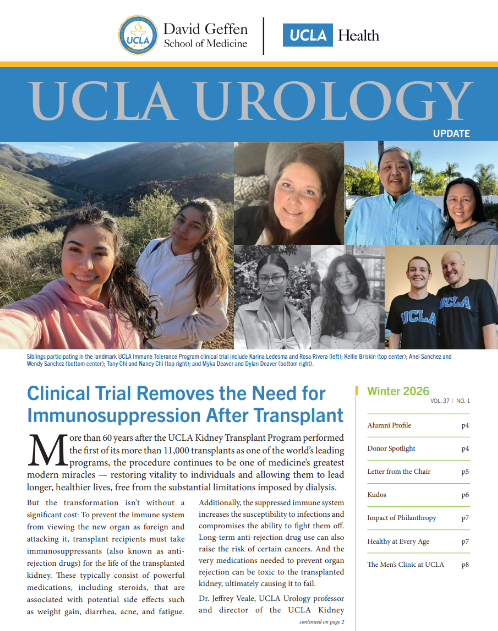
Winter 2026
More than 60 years after the UCLA Kidney Transplant Program performed the first of its more than 11,000 transplants as one of the world’s leading programs, the procedure continues to be one of medicine’s greatest modern miracles - restoring vitality to individuals and allowing them to lead longer, healthier lives, free from the substantial limitations imposed by dialysis.
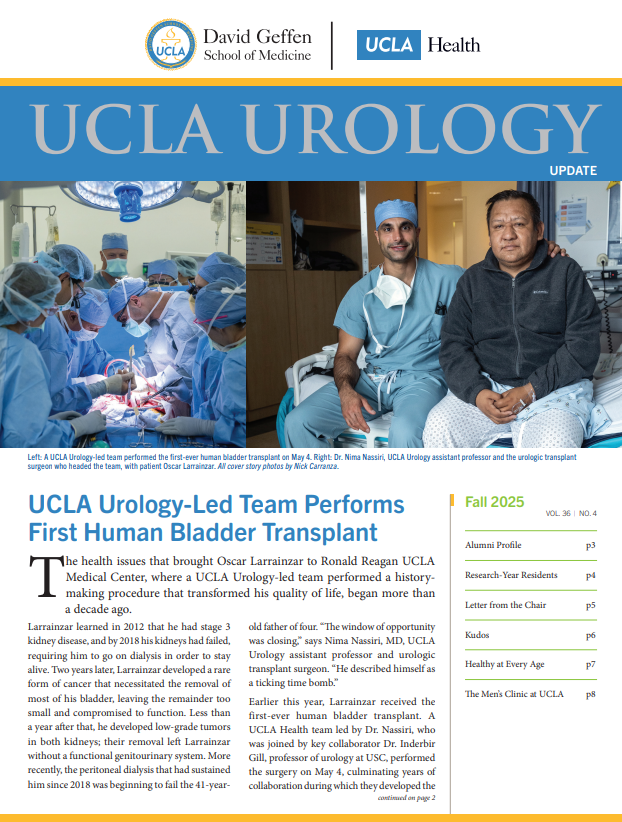
Fall 2025
UCLA Urology-Led Team Performs First Human Bladder Transplant
The health issues that brought Oscar Larrainzar to Ronald Reagan UCLA Medical Center began more than a decade ago. A UCLA Urology-led team at Ronald Reagan UCLA Medical Center performed the world’s first human bladder transplant, dramatically improving his quality of life. The procedure restored his health, energy, and ability to urinate - something he thought he had lost forever.

Summer 2025
Endowed Chairs Bring Flexibility, Funding and Prestige to Top Faculty
Endowed chairs are the highest academic honor at a university, awarded to faculty who have achieved exceptional scholarly distinction. At UCLA Urology, twelve faculty members currently hold endowed chairs, made possible by generous donors. These positions provide lasting funding and flexibility, allowing faculty to focus on innovative research, clinical work, or mentorship without relying solely on traditional grant funding.

Spring 2025
Impact of the Department's Faculty Transcends the Field of Urology
UCLA Urology has a long tradition of excellence in the care of patients with urological conditions, research that identifies new and improved approaches to urological diseases, and training that prepares the next generation of urology leaders. But in many cases, the work of UCLA Urology faculty makes an impact that is felt not only well outside the confines of UCLA, but also beyond urology to other areas of medicine and healthcare.

Winter 2025
Medical Education Team Enables UCLA Urology Trainees to Thrive
Although UCLA Urology’s state-of-the-art patient care and groundbreaking research tends to receive the most public attention, nothing is more important to the department’s mission than the education and training of medical students, residents, and fellows.

Fall 2024
Nutrition and Dietary Strategies Play a Growing Role in Urology
While medications and surgical procedures have historically served as cornerstones of urologic treatment, it's become increasingly clear that for many conditions, the foods and liquids we consume can play a pivotal role in reducing disease risk, avoiding triggers, and improving outcomes.

Summer 2024
Stone Treatment Center Experts Bring Relief for a Painful Condition
It's one of the most common urological conditions, and also among the most painful - when the solid mineral deposits known as stones form and then become lodged in the kidney or elsewhere in the urinary tract. The period of discomfort during a stone episode can be excruciating, and many patients are unable to pass them without treatment. Some patients - including those with challenging anatomies or certain medical conditions - are difficult to treat without special expertise. And once the acute issue is resolved, patients must live with the reality that nationwide up to half of individuals who experience one kidney stone episode will have a second within five years. For all these reasons, the UCLA Stone Treatment Center serves a critical resource in Southern California and beyond.
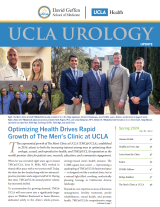
Spring 2024
Optimizing Health Drives Rapid Growth of The Men's Clinic at UCLA
The exponential growth of The Men’s Clinic at UCLA (TMC@UCLA), established in 2016, attests to both the increasing interest among men in optimizing their urologic, sexual, and reproductive health, and TMC@UCLA’s reputation as the world’s premier clinic for patient care, research, education, and community engagement. Beyond its core expertise in areas of hormone management, fertility treatment, penile rehabilitation, sexual health, and prostate health, TMC@UCLA's comprehensive range of services is designed to optimize the health of a population that has traditionally been less engaged in their care.
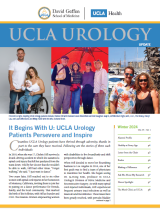
Winter 2023
It Begins With U: UCLA Urology Patients Persevere and Inspire
Countless UCLA Urology patients have thrived through adversity, thanks in part to the care they have received. In 2010, when she was 17, Chelsie Hill survived a drunk-driving accident in which she sustained a spinal cord injury that left her paralyzed from the waist down. Told by her doctor that she wouldn't be able to walk, Hill had other ideas. “Forget walking,” she said. “I just want to dance.” Today, Hill and her husband are raising a healthy girl, Jaelyn, born in January 2023. Additionally, Hill's business, the Rollettes, an all-women's wheelchair dance team, has performed all over the U.S. as well as overseas. Hill credits the treatment she has received at UCLA Urology with making her current life as a wife, mother, and businessperson possible. “If I didn't have the right care, I couldn't be as independent and successful as I am with my disability,” she says. “I'm so thankful that I found UCLA and Dr. Kim.”
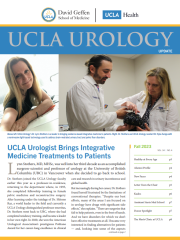
Fall 2023
UCLA Urologist Brings Integrative Medicine Treatments to Patients
Lynn Stothers, MD, MHSc, was well into her third decade as an accomplished surgeon-scientist and professor of urology at the University of British Columbia (UBC) in Vancouver when she decided to go back to school. Dr. Stothers joined the UCLA Urology faculty earlier this year as a professor-in-residence, returning to the department where, in 1995, she completed fellowship training in female pelvic medicine and reconstructive surgery. After learning under the tutelage of Dr. Shlomo Raz, a world leader in the field and currently a UCLA Urology distinguished professor emeritus, Dr. Stothers went back to UBC, where she had completed residency training, and became a leader in her own right. In 2020, she won the American Urological Association's prestigious Politano Award for her career-long excellence in clinical care and research in urinary incontinence and global health.
View complete newsletter >
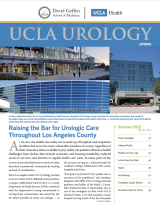
Summer 2023
Raising the Bar for Urologic Care Throughout Los Angeles County
At its core, the health care safety net is made up of hospitals and outpatient facilities that serve the more vulnerable members of society, regardless of their insurance status or ability to pay. Safety net patients often face health challenges from factors that include economic and housing instability, reduced access to services, and barriers to regular health care visits. A unique collaboration built by the L.A. County Department of Health Services, along with UCLA Urology's strong commitment to serving these communities, have resulted in top-quality urology care at three UCLA-affiliated county facilities where the department provides services.
View complete newsletter >
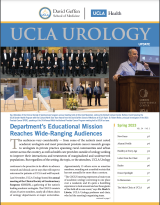
Spring 2023
Department's Educational Mission Reaches Wide-Ranging Audiences
The audiences vary considerably — from some of the nation's most noted academic urologists and most prominent prostate cancer research groups to urologists in private practice spanning rural communities and urban centers across the country, as well as health care providers outside of urology seeking to improve their interactions and treatments of marginalized and underserved populations. But regardless of the setting, the topic, or the attendees, UCLA Urology continues to be proactive in its efforts to advance research and clinical care in ways that will improve outcomes for patients at UCLA and well beyond.
View complete newsletter >
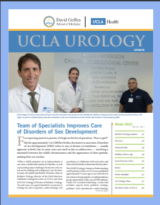
Winter 2022
Team of Specialists Improves Care of Disorders of Sex Development
For expecting and new parents, it's high on the list of questions: “Boy or girl?” But for approximately 1 in 5,000 live births, the answer is uncertain. Disorders of sex development (DSD) refers to any of dozens of conditions — usually apparent at birth, but in some cases not until as late as adolescence — involving a mismatch between the child's chromosomes and the appearance of their genitals, making their sex unclear.
View Complete Newsletter >
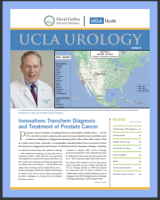
Fall 2022
Innovations Transform Diagnosis and Treatment of Prostate Cancer
Prostate cancer remains a leading threat to the health of older men — in the U.S., it is the second-commonest cause of cancer death in men and the most common malignancy diagnosed among males other than skin cancer. But in a little more than a decade, a remarkable transformation has occurred in how the disease is diagnosed and treated.
View Complete Newsletter >
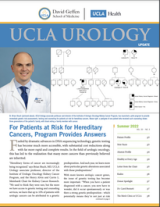
Summer 2022
For Patients at Risk for Hereditary Cancers, Program Provides Answers
Fueled by dramatic advances in DNA sequencing technology, genetic testing has become much more accessible, with substantial cost reductions along with far more rapid and complete results. In the field of urologic oncology, this has led to the realization that many more cancers than previously believed are inherited.
View Complete Newsletter >
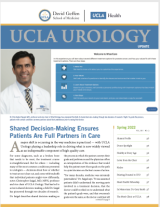
Spring 2022
Shared Decision-Making Ensures Patients Are Full Partners in Care
A major shift is occurring in the way medicine is practiced — with UCLA Urology playing a leadership role in driving what is now widely viewed as an indispensable component of high-quality care.
View Complete Newsletter >
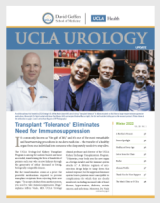
Winter 2022
Transplant ‘Tolerance' Eliminates Need for Immunosuppression
It's commonly known as “the gift of life,” and it's one of the most remarkable and heartwarming procedures in modern medicine – the transfer of a healthy organ from one individual into someone who desperately needs it to stay alive.
View Complete Newsletter >
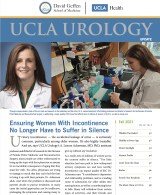
Fall 2021
Ensuring Women With Incontinence No Longer Have to Suffer in Silence
Urinary incontinence — the accidental leakage of urine — is extremely common, particularly among older women. It's also highly treatable. And yet, says UCLA Urology's A. Lenore Ackerman, MD, PhD, assistant professor and director of research for the Division of Female Pelvic Medicine and Reconstructive Surgery, many people are either embarrassed to bring up the topic with their physician or assume it's an inevitable consequence of aging that they must live with.
View Complete Newsletter >
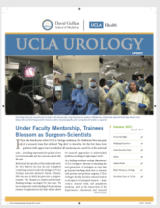
Summer 2021
Under Faculty Mentorship, Trainees Blossom as Surgeon-Scientists
As a leading academic urology department, UCLA Urology is devoted to educating the next generation of urologists in ways that go beyond teaching them how to interact with patients and perform surgeries.
View Complete Newsletter >
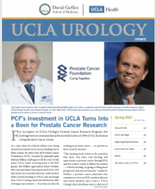
Spring 2021
PCF's Investment in UCLA Turns Into a Boon for Prostate Cancer Research
For its impact on UCLA Urology's Prostate Cancer Research Program, few meetings were as consequential as the one held in June of 1996 at UCLA Health Jonsson Comprehensive Cancer Center.
View Complete Newsletter >
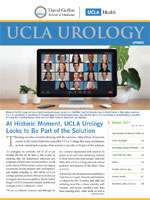
Winter 2021
At Historic Moment, UCLA Urology Looks to Be Part of the Solution
The long-overdue societal reckoning with the centuries-old problem of systemic racism in the United States has compelled UCLA Urology, like many institutions, to look inward and examine what actions it can take to be part of the solution.
View Complete Newsletter >
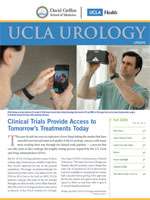
Fall 2020
Posted Sep 04, 2020
Clinical Trials Provide Access to Tomorrow's Treatments Today
The past decade has seen an explosion of new drugs hitting the market that have extended survival and improved quality of life for urologic cancers, with many more working their way through the clinical trials pipeline — a process that can take years as they undergo the lengthy testing process required by the U.S. Food and Drug Administration (FDA).
View Complete Newsletter >
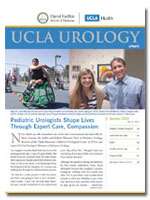
Summer 2020
Posted Jun 09, 2020
Pediatric Urologists Shape Lives Through Expert Care, Compassion
Nicte Mack can still remember one of the first conversations she had with Dr. Steve Lerman, the Judith and Robert Winston Chair in Pediatric Urology, director of the Clark-Morrison Children's Urological Center at UCLA and chief of UCLA Urology's Division of Pediatric Urology.
View Complete Newsletter >
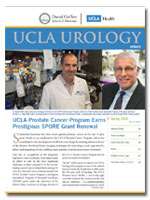
Spring 2020
Posted Mar 04, 2020
UCLA Prostate Cancer Program Earns Prestigious SPORE Grant Renewal
Substantial headway has been made against prostate cancer in the last 15-plus years, thanks in no small part to the UCLA Prostate Cancer Program, which has contributed to the development of effective new drugs for treating advanced forms of the disease; developed better imaging techniques for detecting it; and engendered a better understanding of risk, enabling many patients to avoid unnecessary treatment.
View Complete Newsletter >
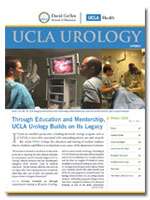
Winter 2020
Posted Dec 04, 2019
Through Education and Mentorship, UCLA Urology Builds on Its Legacy
From an outsider's perspective, a leading university urology program such as UCLA's is most often associated with outstanding patient care and research. But within UCLA Urology, the education and training of medical students, interns, residents, and fellows is as important as any aspect of the department's mission.
View Complete Newsletter >
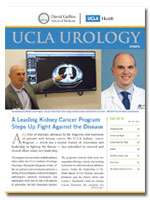
Fall 2019
Posted Sep 18, 2019
A Leading Kidney Cancer Program Steps Up Fight Against the Disease
At a time of dramatic advances in the diagnosis and treatment of patients with kidney cancer, the UCLA Kidney Cancer Program — which has a storied history of innovation and leadership in fighting the disease — has redoubled its research and clinical efforts under new leadership.
View Complete Newsletter >
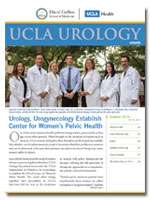
Summer 2019
Posted Jun 26, 2019
Urology, Urogynecology Establish Center for Women's Pelvic Health
One of the most common health problems facing women, particularly as they age, is too often ignored. When brought to the attention of experts such as those at UCLA, women with pelvic floor disorders can be treated successfully. But, whether out of embarrassment, a lack of awareness that their problem is common and can be addressed, or because their primary care physician doesn't bring it up, many women suffer in silence.
View Complete Newsletter >
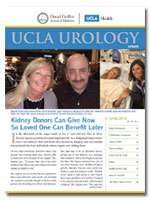
Spring 2019
Posted Mar 21, 2019
Kidney Donors Can Give Now So Loved One Can Benefit Later
In the aftermath of the tragic death of her 21-year-old son Alec in 2016, Kirsten Jepsen experienced something beautiful: As a designated organ donor, Alec's two kidneys, liver and heart were recovered, shipped, and successfully transplanted into four individuals whose organs were failing them.
View Complete Newsletter >
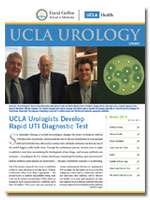
Winter 2019
Posted Nov 27, 2018
UCLA Urologists Develop Rapid UTI Diagnostic Test
Sir Alexander Fleming, a Scottish bacteriologist, changed the course of medicine with his 1928 discovery of penicillin, which paved the way for the use of antibiotics to treat patients with bacterial infections. But nearly a century later, antibiotic resistance has become one of the world's biggest public heath crises. Through the evolutionary process, bacteria learn to adapt to antibiotics over time, necessitating the development of new drugs.
View Complete Newsletter >
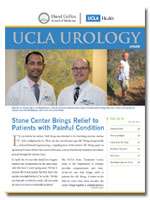
Fall 2018
Posted Oct 03, 2018
Stone Center Brings Relief to Patients with Painful Condition
Even before he retired, Neil Wong was devoted to his morning exercise routine with a religious fervor. Then one day several years ago, Mr. Wong unexpectedly found himself experiencing a crippling level of discomfort. Mr. Wong spent an agonizing 36 hours before the source of his pain, a stone that had developed in his kidney, passed through his urinary tract.
View Complete Newsletter >
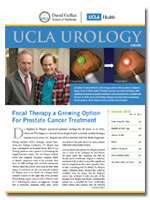
Summer 2018
Posted Jul 11, 2018
Focal Therapy a Growing Option For Prostate Cancer Treatment
Dr. Stephen R. Shapiro practiced pediatric urology for 38 years, so in 2016, when his PSA began to rise and his urologist found a prostate nodule during a routine rectal exam, Dr. Shapiro was all too familiar with the likely diagnosis. Having attended UCLA Urology's annual State-of-the-Art Urology Conference, Dr. Shapiro had seen a presentation by Leonard Marks, MD, UCLA Urology professor and a pioneer in developing the targeted prostate biopsy.
View Complete Newsletter >

Spring 2018
Posted Mar 14, 2018
“North Campus” Expansion Starts in Burbank, Santa Clarita
For patients seeking compassionate, personalized and innovative urological care, the Westside of Los Angeles, home of UCLA, has long been a destination of choice. Consistently ranked among the nation's top four urology programs in the U.S. News & World Report annual survey, UCLA Urology boasts some of the leading physicians and researchers in the field, drawing patients — in some cases from great distances — for state-of-the-art treatment of rare and common conditions alike.
View Complete Newsletter >
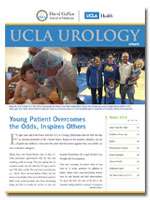
Winter 2018
Posted Nov 16, 2017
Young Patient Overcomes the Odds, Inspires Others
Eight-year-old Evan Beier tells his UCLA Urology physicians that he will one day be elected president of the United States. Based on his positive attitude, can-do spirit and ability to overcome the odds that have been against him since birth, no one is about to disagree.
View Complete Newsletter >
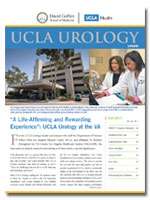
Fall 2017
Posted Sep 20, 2017
“A Life-Affirming and Rewarding Experience”: UCLA Urology at the VA
For the UCLA Urology faculty and trainees who staff the Department of Veterans Affairs West Los Angeles Medical Center (WLA) and affiliated VA facilities throughout the VA Greater Los Angeles Healthcare System (VAGLAHS), the time spent in clinical, research and training activities carries a special significance.
View Complete Newsletter >
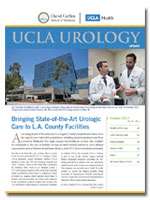
Summer 2017
Posted Jun 28, 2017
Bringing State-of-the-Art Urologic Care to L.A. County Facilities
As an integral part of the safety net, Los Angeles County's hospitals and clinics serve the region's most vulnerable populations, including uninsured patients and those covered by Medicaid. One might assume that healthcare at these sites wouldn't be comparable to the care at facilities serving privately insured patients in more affluent communities such as Westwood and Santa Monica, where UCLA's two hospitals are located.
View Complete Newsletter >
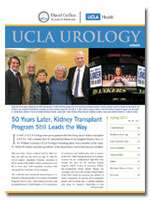
Spring 2017
Posted Apr 05, 2017
50 Years Later, Kidney Transplant Program Still Leads the Way
In 1967, a UCLA Urology team participated in the first living-donor kidney transplant at UCLA. Ted Lombard, then 38, donated his kidney to his daughter Denice, then 13. Dr. Willard Goodwin, UCLA Urology's founding chief, was a member of the team. Dr. Robert B. Smith, currently a professor in the department, was on the team as a resident.
View Complete Newsletter >
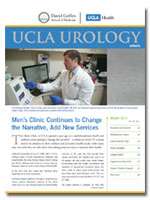
Winter 2017
Posted Nov 16, 2016
Men's Clinic Continues to Change the Narrative, Add New Services
The Men's Clinic at UCLA opened a year ago as a multidisciplinary health and wellness center aiming to “change the narrative” – a culture in which U.S. women tend to be attentive to their wellness and preventive health needs, while many men wait until they are sick rather than taking proactive steps to optimize their health.
View Complete Newsletter >
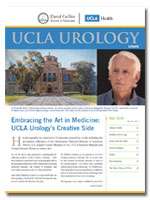
Fall 2016
Posted Aug 30, 2016
Embracing the Art in Medicine: UCLA Urology's Creative Side
His photographs are featured in 19 museums around the world, including the permanent collections of the Smithsonian National Museum of American History, Los Angeles County Museum of Art, UCLA Hammer Museum and George Eastman House, to name a few. Dr. Richard M. Ehrlich, UCLA Urology professor emeritus, has built a successful second career as a fine-art photographer.
View Complete Newsletter >
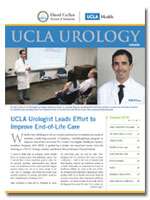
Summer 2016
Posted Jun 16, 2016
UCLA Urologist Leads Effort to Improve End-of-Life Care
Whether he's fulfilling his role as a mentor and teacher of residents and medical students, conducting research, or heading a multidisciplinary program to improve end-of-life care at the VA Greater Los Angeles Healthcare System, Jonathan Bergman, MD, MPH, is guided by a simple but important lesson from his training as a UCLA Urology resident and Robert Wood Johnson Clinical Scholar.
View Complete Newsletter >
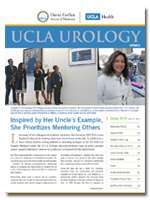
Spring 2016
Posted Apr 13, 2016
Inspired by Her Uncle's Example, She Prioritizes Mentoring Others
Like many of her colleagues in academic medicine, Isla Garraway, MD, PhD, could hardly be blamed for wishing there were more hours in the day. In addition to a busy clinical practice seeing patients as attending urologist at the VA West Los Angeles Medical Center, the UCLA Urology associate professor runs an active prostate cancer research laboratory and serves as director of research for the department.
View Complete Newsletter >
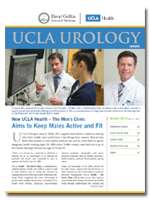
Winter 2016
Posted Nov 18, 2015
New UCLA Health – The Men's Clinic, Aims to Keep Males Active and Fit
UCLA Urologist Jesse N. Mills, MD, suggests that when it comes to looking after their health, men could learn a few things from women. Men are less likely than women to seek routine medical care and are more likely to ignore dangerous health warning signs, Dr. Mills notes. Unlike women, men tend not to go in for routine checkups between the ages of 18 and 50.
View Complete Newsletter >
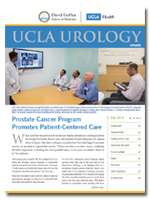
Fall 2015
Posted Sep 23, 2015
Prostate Cancer Program Promotes Patient-Centered Care
When Jon Post was advised by his doctor that he should see a urologist about his rising PSA levels, the 56-year-old resident of San Clemente, CA, stayed close to home. But when a biopsy revealed that Post had Stage II prostate cancer, he decided to expand his search. “When you hear you have cancer, suddenly all that's important is finding the best possible place to be seen, no matter where it is,” he explains.
View Complete Newsletter >

Summer 2015
Posted Jul 06, 2015
New Spaces Promote Comfort, Convenience, and Better Care
UCLA Urology is growing. In Westwood and Santa Monica, and for patients with wide-ranging urological needs, the department is expanding access to its services with new and larger spaces. But size is only part of the story. Through a purposeful and coordinated effort, the new facilities are bringing together diverse teams of experts and trainees in ways that promote more communication and, as a result, enhanced training and clinical care. And through more attractive and centralized facilities, the growth is dramatically improving the patient experience.
View Complete Newsletter >
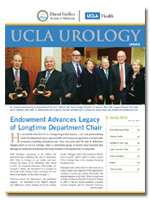
Spring 2015
Posted Mar 12, 2015
Endowment Advances Legacy of Longtime Department Chair
He carried the reins for UCLA Urology longer than anyone – a 27-year period during which the department grew exponentially and became recognized as a world leader in research, teaching and patient care. Now, four years after Dr. Jean B. deKernion stepped down as UCLA Urology chair, a committed group of donors have honored him through an endowment fund that will bring benefits to the department in perpetuity.
View Complete Newsletter >
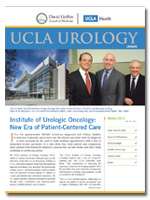
Winter 2015
Posted Dec 01, 2014
Institute of Urologic Oncology: New Era of Patient-Centered Care
For the approximately 400,000 Americans diagnosed with kidney, bladder, testicular or prostate cancer each year, the anxiety associated with the diagnosis is often increased by the need to make multiple appointments with a slew of disparately located specialists. At a time when they need comfort and compassion, many patients find themselves mired in a process that can take weeks, and often yields confusing or conflicting advice.
View Complete Newsletter >
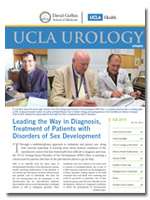
Fall 2014
Posted Oct 09, 2014
Leading the Way in Diagnosis, Treatment of Patients with Disorders of Sex Development
Through a multidisciplinary approach to evaluation and patient care, along with national leadership in learning more about medical conditions of the reproductive system that have historically been difficult to diagnose and treat, the UCLA Urology-based Disorders of Sex Development (DSD) Clinic is meeting a critical need for patients who have in the past had few places to go for help.
View Complete Newsletter >
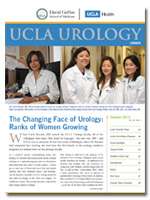
Summer 2014
Posted Jun 27, 2014
The Changing Face of Urology: Ranks of Women Growing
When Carol Bennett, MD, joined the UCLA Urology faculty, all of her colleagues were male. This wasn't so long ago – the year was 1996 – and UCLA was no anomaly. At the University of Michigan, where Dr. Bennett had completed her training, she had been the first female in the urology residency program; no women were on the urology faculty.
View Complete Newsletter >
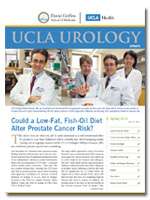
Spring 2014
Posted Mar 17, 2014
Could a Low-Fat, Fish-Oil Diet Alter Prostate Cancer Risk?
The cliché “you are what you eat” is easily dismissed as a well-intentioned effort by parents to coax their children to follow a healthy diet. But if intriguing results coming out of ongoing research led by UCLA Urologist William Aronson, MD, are confirmed, parents may be on to something.
View Complete Newsletter >
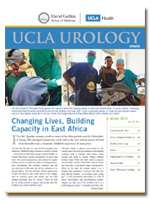
Winter 2013
Posted Nov 27, 2013
Changing Lives, Building Capacity in East Africa
For the Ugandan woman, as with so many of the other patients seen by Christopher Tarnay, MD, during his annual two-week visits to the East African nation, life had been miserable since a traumatic childbirth experience 20 years prior. On that day she had not only lost her daughter, but suffered a childbirth injury known as obstetric fistula – a hole between the birth passage and the bladder or rectum that leaves women incontinent to urine and stool.
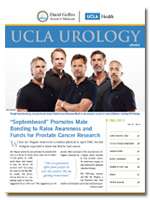
Fall 2013
Posted Sep 06, 2013
“Septembeard” Promotes Male Bonding to Raise Awareness and Funds for Prostate Cancer Research
When Art Wagner went in for a routine physical in April 2009, the last thing he expected to learn was that he had cancer. Mr. Wagner admits he was motivated to make his first visit to a doctor in about seven years out of vanity. “I had gotten in really good shape and wanted to hear the doctor tell me how well I was doing for a guy in my late 40s,” he recalls.
View Complete Newsletter >
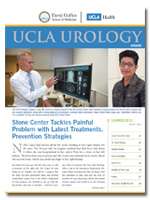
Summer 2013
Posted Jul 27, 2013
Stone Center Tackles Painful Problem with Latest Treatments, Prevention Strategies
Nellie Lopez had known about the stone residing in her right kidney for 40 years. The 70-year-old Los Angeles resident had first been told about it when she was hospitalized in her native Peru for a stone in her left kidney. The first stone was resolved, and Ms. Lopez was advised not to worry about the second stone, which was small and high in her right kidney.
View Complete Newsletter >
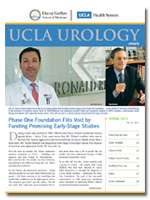
Spring 2013
Posted Mar 19, 2013
Phase One Foundation Fills Void by Funding Promising Early-Stage Studies
During a nine-day stretch in 1998, Alberto and Stacy Valner's world was turned upside down – twice. First came news that Mr. Valner's mother, who was in her late 50s, had an aggressive and terminal form of cancer. Barely more than a week later, Mr. Valner himself was diagnosed with Stage 4 testicular cancer. His chances of survival were placed at 50/50. He was only 36.
View Complete Newsletter >
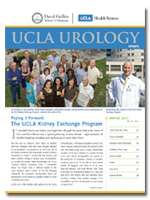
Winter 2013
Posted Dec 13, 2012
Paying it Forward: The UCLA Kidney Exchange Program
If you didn't know any better, you might have thought the party held at the home of Fern and Ross Bloom was a typical gathering of close friends – approximately 20 families laughing, mingling and catching up on each other's lives. But this was no ordinary party: These 20 families had been strangers until they were brought together by extraordinary circumstances. In each case, one of the family members had desperately needed a kidney transplant to resume a normal life, but spouses and other relatives willing to donate were incompatible.
View Complete Newsletter >
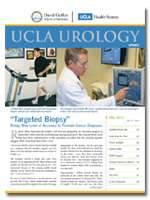
Fall 2012
Posted Oct 16, 2012
“Targeted Biopsy” Brings New Level of Accuracy to Prostate Cancer Diagnosis
Robert Meier had torn his rotator cuff and was preparing for shoulder surgery in September 2008 when he received some unexpected news: The routine blood work that had been ordered prior to the operation revealed that his prostate-specific antigen (PSA) level had risen from 4 to 6. “The doctor said this wasn't normal, and that I should see a urologist after the shoulder surgery,” says Mr. Meier, a 58-year-old high school visual arts teacher in Visalia, CA.
View Complete Newsletter >
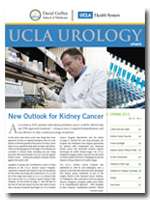
Spring 2012
Posted June 11, 2012
New Outlook for Kidney Cancer
As recently as 2005, patients with advanced kidney cancer could be offered only one FDA-approved treatment – a drug so toxic it required hospitalization, and was effective in only a small percentage of patients. In the seven years since, seven new drugs have been approved. Known as targeted therapies, they not only shrink or slow the growth of the tumor, but they can be taken on an outpatient basis with far fewer side effects.
View Complete Newsletter >
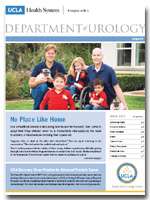
Winter 2012
Posted Jan 26, 2012
No Place Like Home
Ben Armentrout-Wiswall is discussing how he and his husband, Tom, came to adopt their three children when he is momentarily interrupted by the need to address a misadventure involving their 2-year-old. “Augustus likes to climb in the other kids' wheelchairs,” Ben says upon returning to the conversation. “Then he buckles the seatbelt and can't get out.” There's nothing unusual about a father of three young children experiencing difficulty getting through a discussion without frequent timeouts to attend to his kids' needs. But the wheelchairs in the Armentrout-Wiswall home signify that this family is anything but typical.
View Complete Newsletter >
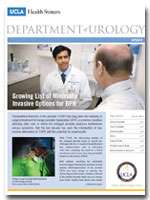
Fall 2010
Posted Jan 06, 2011
Growing List of Minimally Invasive Options for BPH
Transurethral resection of the prostate (TURP) has long been the mainstay of surgical treatment for benign prostatic hyperplasia (BPH), a common condition affecting older men in which the enlarged prostate produces bothersome urinary symptoms. But the last decade has seen the introduction of less invasive alternatives to TURP, with the potential for equal results.
View Complete Newsletter >
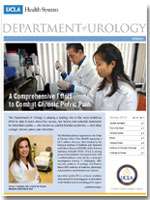
Spring 2010
Posted June 16, 2010
- A Comprehensive Effort to Combat Chronic Pelvic Pain
- Alumni and Donor Spotlight
- Clinical Update
- Kudos
- Clinical Trials
- Institute of Urologic Oncology
- Comings & Goings
- View Complete Newsletter >
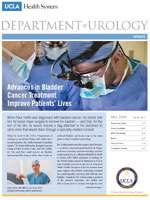
Fall 2009
Posted December 15, 2009
- Advances in Bladder Cancer Treatment Improve Patients' Lives
- Alumni Spotlight
- Donor Spotlight
- BPH UDA Study
- Kudos
- Clinical Trials
- Comings & Goings
- View Complete Newsletter >
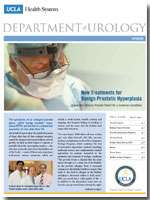
Fall 2008
Posted February 3, 2008
- New Treatments for Benign Prostatic Hyperplasia
- Kidney Cancer Vaccine
- Erectile Dysfunction Research
- Clinical Trials
- View Complete Newsletter >
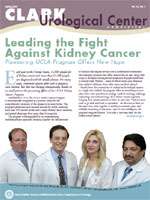
Spring 2007
Posted June 7, 2007
- Leading the Fight Against Kidney Cancer
- Prostate Cancer Program
- Kidney Cancer Program: Targeted Drugs
- Kidney Cancer Program: Research
- View Complete Newsletter >
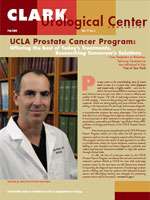
Fall 2006
Posted January 11, 2007
- UCLA Prostate Cancer Program
- Integrative Urology Program
- Proper Care of Children with Chronic Kidney Failure
- Kidney Cancer Program Announces New Medical Director
- Clinical Trials at UCLA
- View Complete Newsletter >
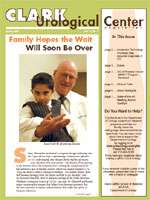
Spring 2006
Posted June 20, 2006
- Urosensor Technology Promises Fast, Accurate Diagnosis of UTI
- UCLA Prostate Cancer IMPACT Program Renewed
- Clinical Trials
- State-of-the-Art Meeting
- View Complete Newsletter >
Summer 2005
Posted January 18, 2006
- Engineering New Treatments
- A letter from the Chairman
- A Special Gift/An Artist's Appreciation
- View Complete Newsletter >
Spring 2005
Posted May 12, 2005
- Keeping Count - The Burden of Urologic Diseases
- Clinical Trials in Urology
- Legislation Would Bolster IMPACT Funding
- View Complete Newsletter >
End of Year 2004
Posted February 23, 2005
- Research Funding and Discoveries
- Clinical Programs
- Educational Programs
- Future Initiatives
- View Complete Newsletter >
Fall 2004
Posted October 22, 2004
- Eating Right - Can it Prevent Prostate Cancer
- All in the Family
- Clinical Trials at UCLA in Urology
- View Complete Newsletter >
Spring 2004
Posted May 6, 2004
- Sister Act, Twin Receives the Ultimate Gift
- Early-Stage Postate Cancer Treatments at UCLA
- Multidisciplinary Bladder Cancer Program Launched
- Bladder Cancer Studies Show Promise
- View Complete Newsletter >
Fall 2003
Posted March 3, 2004
- Experimental Approach to Prostate Cancer Diagnosis Sheds New Light, Could Guide Future Treatment
- Urology Residents Probe Key Issues in Research Year
- Applying Successful Melanoma Strategy, Research Team Looks to Develop Targeted Kidney Cancer Vaccine
- View Complete Newsletter >
Summer 2003
Posted November 11, 2003
- Paving New Ground...in the Clinic and in the Lab
- Laboratory Findings Lead to Trial of Immunosuppressant
- Delicate Surgery Completes Turnaround for Patient who was Once Gravely Ill
- View Complete Newsletter >
Spring 2003
Posted November 11, 2003
- Kidney Cancer Program Offers New Hope to Patients
- Research, Experimental Options Redefine Treatment
- Former Patient Enjoys Life After Near Death
- Minimally Invasive Surgery Goes Small(er)
- View Complete Newsletter >